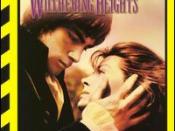Romanticism, the literary movement traditionally dated 1798 to 1832 in England, affected all the arts through the nineteenth century. Wuthering Heights is frequently regarded as a model of romantic fiction. What is more, it is said to construct a biography of BrontÃÂ's life, personality, and beliefs. In the novel, she presents a world in which people marry early and die young, just like they really did in her times. Both patterns, early marriage and early death, are considered to be Romantic, as most artists of the Era died young. What BrontÃÂ describes in the novel is what she knows personally, those are scenes somehow taken from her own life and experience that the reader encounters while reading the novel, and it is to say that her own process of growing up puts a great impact on her writings. The values she had learnt from her father brought Emily close to nature, the same appreciation of the beauties of nature can be found in Catherine's character of Wuthering Heights, the author would also spend her free time wandering on the Yorkshire moors.
Similarly, the games Emily played with her siblings developed her imagination to the level which allowed her to create the world of the novel that exists in different literary dimensions (Nestor 2003). Wuthering Heights belongs to the Victorian Era, however, consists primarily of Romantic elements, which is because BrontÃÂ was of romantic nature. The novel depicts the story of romantic love, deep passion, it puts emphasis on nature and individual, all these enclosed in original and imaginative form.
There are many aspects of the novel which distinguish it from other works of Emily's times. The author rejects literary conventions, and one may easily notice that she presents herself in a view of the artist as a supremely individual creator.


